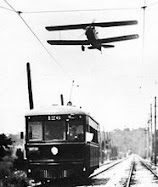 Pittsburgh, PA. Where BRT ridership has
Pittsburgh, PA. Where BRT ridership has become worse each year, are we next?
Jacksonville's Busway to Bust
Would YOU Buy It?
Jacksonville...For whatever reason, a fixed guideway transit system, be it rail, monorail, people mover, trolley bus, or busway, always does better in passenger loads then a flexible type system. Sadly, buses ARE flexible transit in motion and the downside is, they are inferior in attracting a crowd. The Bus Rapid Transit Planners, tell us, "BRT could carry as many passengers as rail," or "BRT uses unique branded vehicles", or "BRT can be as fast as rail", or even their trademark slogan, "BRT is just like rail only cheaper".
Does BRT carry as many passengers as rail? Worldwide, the numbers tell a different story, BRT is not even close. In the few markets where it has excelled, Bogota and Curitiba, Brazil, both Cities are now planning a rail based Metro to replace the BRT trunk lines. This means the taxpayers will have to ante up for two transit systems, when they had a need for only one!
Branded Vehicles? Does this make a difference? Ask yourself if a blue bus will get you home any better then a red bus? How about a bus that is wrapped with advertising? Sorry to say, no matter what you do to the basic vehicle, paint, brand names, hide the wheels behind skirts trying to fool people into thinking they are rail vehicles. WHATEVER! It is still a bus.
BRT could drive as fast as rail? National averages place BRT dead in the middle between regular City Bus Transit and Light Rail Transit in speeds. While it is true the bus COULD go much faster, 50 or 60 miles per hour, the real world conditions of narrow busways or freeway HOV lanes, preclude it from achieving anything but short bursts of speed. Rail on the other hand can and does travel as fast as 79-90 miles per hour in many markets. If they manage to get a BRT bus up to those speeds, I don't want to be on it.
Is BRT really just like rail but cheaper? I'll give this statement the most honest answer I can by picking it apart. As we have seen in speed, usage, or guideway attractiveness it is NOT like rail. Likewise, in spite of JTA's claims, it isn't going to cause any private developers to run to the busway and unload a 200 million dollar building project, because it's a magic bus. The flexibility of the bus routes, and the fact that if BRT falters it can be quickly changed, is the very reason mass development won't happen along it's routes. Lastly, you won't see a single bus operator, pulling 9 more coaches down the street. For that reason alone, bus costs more to operate.
So is your host anti bus or BRT? Not in the least! BRT has a huge role to play in our transit future, both at home and across the nation, just don't try and sell it as a "Trunk Line" or "Mainline Transit." Jacksonville would soar to national and international prominence simply by going with rail, where we already have tracks. Next our City should be building a urban, ground based people mover system such as modern streetcars or even traditional streetcars. Complete the Skyway into the near urban neighborhoods and link it to a system of park and ride, easy exit, easy entrance, transit centers built around the City core. The transit centers would serve to transfer passengers from Auto, Commuter Rail, BRT, Bus, to downtown streetcars, Skyway and Trolley buses.
Quite simply put, everything has it's place and mix sells in transit just like it does at your favorite department store. Skyway, Streetcar and real electric trolley shuttle buses downtown would keep our urban heart clean and very mobile. Building a core on systems that are permanent would open a World of new smog-free development. In the suburbs, Commuter Rail could race for St. Augustine, Green Cove Springs, Orange Park, Flemming Island, NAS JAX, Nocatee, JIA, Baldwin, Marietta, Yulee and Fernandina Beach. From the transit centers BRT and regular City Buses could reach into the Beaches, JTB, Normandy, Blanding, Middleburg, Mandarin, Lem Turner, Edgewood, Moncrief, and Martin Luther King, using less costly HOV and restricted lanes, with some signal priority.
Jacksonville could go from distant follower, to true leader, if we just stand up and lead! Mister Mayor? I'll volunteer!










































